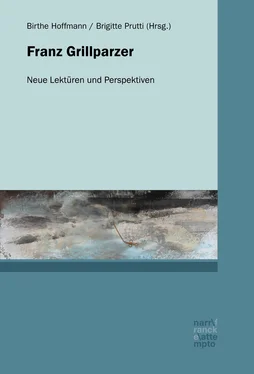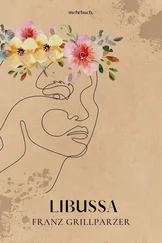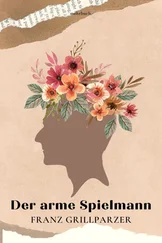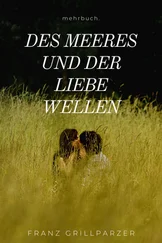Just as Grillparzer was critical of narratives of progress and felt dubious about the possibility of epistemological certainty, Das Kloster bei Sendomir reflects a world in which stability, insight, and human perfectibility are unobtainable. Set in 17 th-century Poland, a country that in the 18 thcentury would suffer three partitions at the hands of the Habsburg Empire, Prussia, and Russia, and in the city of Sandomierz, which, in Grillparzer’s lifetime, was ruled alternately by Austria and Russia, Grillparzer embeds his story in a topography whose stability, as Grillparzer’s readers know, exists on borrowed time10 and whose state will soon, beyond the frame of the story, be as fractured and torn as Vienna’s intellectual landscape in Metternich’s Austria. It is, then, on this fraught terrain that we encounter Grillparzer’s protagonist, an emotionally unstable monk who relates the story of the monastery’s origins and who turns out to be identical to the hero of the framed narrative he presents, the Graf Starschensky.
The epistemological uncertainty that marks Grillparzer’s text announces itself already in its subtitle: „Nach einer als wahr überlieferten Begebenheit.“ The formulation sidesteps a more direct statement – such as „Nach einer wahren Begebenheit” – an element typical of the novella genre, of course. Instead, the phrasing makes plain that the title’s implied narrator is not willing or able to vouch for the truth value of the text’s events. Rather, the responsibility for the truth – or lack thereof – of the events is delegated to the anonymous forces of Überlieferung. 1
The subtitle gives way to a narrative that we will soon identify as the novella’s frame. A broad vision of the Sendomir province’s landscape narrows into a close-up description of „zwei Reiter“ approaching the eponymous monastery:
Die Kleidung der späten Gäste bezeichnete die Fremden. Breitgedrückte, befiederte Hüte, das Elenkoller vom dunklen Brustharnisch gedrückt, die straffanliegenden Unterkleider und hohen Stulpenstiefel erlaubten nicht, [die Reiter] für eingeborne Polen zu halten. Und so war es auch. Als Boten des deutschen Kaisers zogen sie, selbst Deutsche, an den Hof des kriegerischen Johann Sobiesky, und, vom Abend überrascht, suchten sie Nachtlager in dem vor ihnen liegenden Kloster. (SW 3: 119 [my italics])
Here, the representation of textiles in particular evokes affect through an emphasis on their haptic qualities. The narrative reflects on the nexus of vision, touch, and the textual construction of meaning. Having been prompted by Schreyvogel to turn his Sendomir sketch into a prose story, Grillparzer seems to probe the notion of Stoff in all of its senses – sujet , matter, substance, textile. Though the Bezeichnung the visual appearance of the textiles accomplishes in the passage above is one of exclusion and circumscription, the text here nevertheless invites the reader to imagine a tactile relationship with the characters in the text: terms like „gedrückt“ and „straffanliegend“ suggest intimacy as the textiles literally touch and press against the bodies of the characters. The visual assessment of the characters we are allowed to perform, along with the invitation to slip into their skin and imagine the feel of their clothes on their bodies, ultimately yields only negative insights, though: the „Reiter“ must be Fremde ; and their appearance excludes the possibility that they could be „eingeborne Polen.“ Further insight can only be granted by a narrator who we thought was sharing all of his knowledge all along, but who instead apparently toyed with us and now asserts his omniscience belatedly with the pronouncement „Und so war es auch.”2
The epistemological uncertainty that pervades the narrative frame is evident as the two imperial messengers approach the monastery to ask for shelter for the night. A „Pförtner“ invites them in, but he states that the abbot will not be able to welcome them as evening prayers are already in progress. The narrator continues:
Die Angabe des etwas mißtrauisch blickenden Mannes ward durch den eintönigen Zusammenklang halb sprechend, halb singend erhobener Stimmen bekräftigt , die, aus dämpfender Ferne durch die hallenden Gewölbe sich hinwindend, den Chorgesang einer geistlichen Gemeine deutlich genug bezeichneten . (SW 3: 119 [my emphases])
It is the gatekeeper whose gaze is described as „mißtrauisch,“ but his attitude of mistrust curiously seems to be transferred both to the „Fremden“ themselves and to us as readers. The gatekeeper’s „Angabe” – possibly just a neutral statement – morphs under his mistrustful gaze into a mere claim that needs to be „bekräftigt.“ This Bekräftigung , though, is in turn weakened by the paradoxical auditory sensation of an „eintönige[r] Zusammenklang“ of voices that are „halb sprechend, halb singend” – hovering, as it were, between the realms of the prosaic and the poetic. To make matters worse, the voices are perceived only in a muffled manner, „aus dämpfender Ferne,“ and distorted through „hallende Gewölbe.“ All of these qualifiers result in a signification that is merely „deutlich genug,“ but not necessarily beyond doubt. The narrator seems to imply here that we as readers may have to settle for a truth value that is just about good enough – “deutlich genug” – and that ultimate knowledge, whether sought with touch, vision, or even hearing, remains obscured in a world in which our sensual perception is imperfect.
The passage quoted above can also point us to another one of Grillparzer’s poetological observations: „Der wesentliche Unterschied der Novelle vom Drama besteht darin, daß die Novelle eine gedachte Möglichkeit, das Drama aber eine gedachte Wirklichkeit ist.“ (SW 3: 292) As Katherine Arens puts it in her gloss on Grillparzer’s statement, the novella genre, then, „has probability rather than realism on its side.”3 In a literary space in which realism is not the coin of the realm, we have to settle for the possible and the probable – that which is „deutlich genug.“
From the „deutlich genug“ signification in the acoustic realm, the messengers now move into an architectural space that aims to signify through „absichtliche […] Genauigkeit“:
Die beiden Fremden traten in das angewiesene Gemach, welches, obgleich, wie das ganze Kloster, offenbar erst seit kurzem erbaut, doch altertümliche Spitzformen mit absichtlicher Genauigkeit nachahmte. (SW 3: 119 [my italics])
Paradoxically, the „absichtliche Genauigkeit“ of the stylistic imitation both conceals and reveals the artificiality and inauthenticity of the monastery’s architecture. Additionally, the faux-Gothic style points us back towards the Middle Ages and simultaneously forward, beyond the text’s diegetic era of the 17 thcentury’s Ottoman wars, and towards the time of Grillparzer’s writing of the text and Romanticism’s Gothic revival.4 Beyond the fact that here we once again encounter an unstable temporality, the pseudo-Gothic monastery is, of course, a trope that signals to us that we are about to enter Schauerromantik terrain.
True to Schauerromantik conventions, the text soon introduces us to „eine seltsame Menschengestalt“ wrapped in „ein abgetragenes, an mehreren Stellen geflicktes Mönchskleid, das sonderbar genug gegen den derben, gedrungenen Körperbau abstach“ (SW 3: 120).1 The prolonged touch between body and clothing captured in the term „abgetragen“ draws us into a degree of intimacy with the monk from which we instinctively recoil. We experience relief from this discomfort through the distancing effect produced by the visual Abstechen of the robe from the „derben, gedrungenen Körperbau.“ The detailed description of the monk’s appearance ends with a passage focused on his gaze:
Читать дальше












